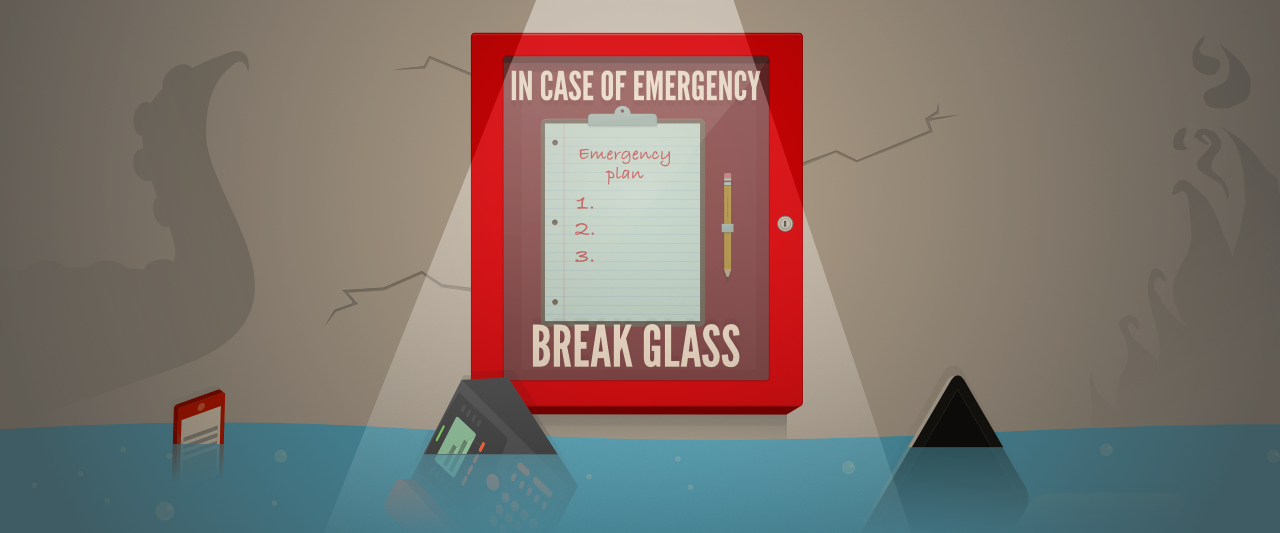Disaster strikes! At least you have a disaster recovery plan... right?
Water is pouring into the server room, which now looks like it belongs on the set of postapocalyptic dud Waterworld.
OR
Laptops are buried under rubble after a construction crane barrelled into your office.
OR
A hacker from a far-off country is demanding a ransom in exchange for your stolen data...
OR
The restaurant on the first floor of your office building had a kitchen fire and all your telephones have melted.
SO...
Is it time to start panicking? Well, that depends.
For the 40% of small businesses that won’t ever recover from a natural disaster, floor, fire or pirate attack due to lack of preparedness, the time has indeed come to bitterly curse, regret and rue the day that an effective disaster recovery plan wasn’t put in place.
You'll kick (or punch) yourself for not being better prepared.
And then there’s the other 60% that did their homework. Catastrophes like these may not cause utter joy and delight, but they won’t be the end of the world, either. At least they can resume their operations quickly!
Expect the worst: plan for disaster recovery
Do you enjoy imagining the worstcase scenario? Does your vivid imagination engulf you in unparalleled paranoia? Then this exercise in disaster recovery was made for you! The first step is one of the most essential stages of protection and entails identifying potentially problematic situations and assessing the risks. All disaster scenarios should be considered, from flooding to major blackouts.
You should also look at how your company’s activity could be affected after a disaster. Analyzing potential repercussions will help you envision what a major disruption would do to your business. Take stock of the key services offered by your company, for both the health and safety of your employees and the survival of the organization itself.
Make a plan (and make sure you can get a hold of it if the end of the world comes)
Once you’ve established all possible scenarios, and you haven’t already succumbed to a panic attack or a major bout of anxiety, you’ll be ready to prepare three distinct documents.
Why three? We’ll get to that. But first, promise us one thing:
THAT YOU DON’T PROCRASTINATE WITH THE DESIGN OF THIS THREE-PART DISASTER RECOVERY PLAN.
Yes, you’re busy. We all are. But if you have the time to scroll through your Instagram feed eight times a day, binge-watch the third season of Riverdale or wash your car every week, postpone one of these absolutely crucial tasks and spend some time on your disaster recovery plan instead.
Your three documents consist of a response plan (how to limit damage), a disaster recovery plan (how to react quickly to set the company back on track), and lastly, a business continuity plan (how to keep your business running while waiting for damage to be repaired).
For each plan, you’ll need to assign roles to prevent additional chaos. If everyone knows what they’re supposed to do during a given situation, you’ll be maximizing your team’s safety and minimizing further damage.
Run disaster recovery drills
Practice makes perfect. You could always run into your office screaming, “Fire!” But try as you might to explain afterwards that simulation is a major part of establishing the emergency plan, your colleagues might not be thrilled about this particular exercise.
On to plan B: an actual fire drill. Make sure everyone knows where the emergency exits are located as well as the action plan for recovering your data and accessing your communication tools remotely.
That way, when the worst happens, everyone will make it out unharmed and you’ll be prepared to get back to business as quickly as possible.
Your three documents consist of a response plan, a disaster recovery plan, and lastly, a business continuity plan.
The cloud to the rescue
The cloud is definitely the best way to transfer vacation pictures from one device to another. Just one click and the image of your charred body under the Riviera Maya sun is instantaneously archived and accessible from any platform. But for a company, having a data mirroring system in the cloud and copies of files outside of the company’s walls is more than just convenient—it’s a matter of survival.
And don’t forget the old school communication channel. The cloud also lets you regain access to your phone lines in the blink of an eye, meaning you can set up temporary offices to get business rolling again.
In the Riviera Maya? You do you.
As for insurance, it usually comes at a painfully steep cost. We won’t argue with you. But they say you can’t put a price on peace of mind. I mean, you can, but it’s really expensive. You can always run the risk of not having any. That way, you could join the (not very exclusive) club of the 40% of small businesses that shut down after a disaster.
We’ll let you decide.






